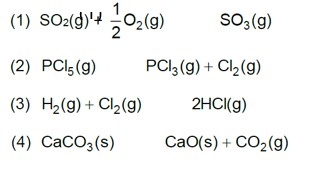7.24. Calculate (a) ∆Gϴ and (b) the equilibrium constant for the formation of NO2 from NO and O2 at 298 K
NO (g) + ½ O2 (g)⇌ NO2 (g)
where
ΔfGϴ (NO2) = 52.0 kJ/mol
ΔfGϴ (NO) = 87.0 kJ/mol
ΔfGϴ (O2) = 0 kJ/mol
7.24. Calculate (a) ∆Gϴ and (b) the equilibrium constant for the formation of NO2 from NO and O2 at 298 K
NO (g) + ½ O2 (g)⇌ NO2 (g)
where
ΔfGϴ (NO2) = 52.0 kJ/mol
ΔfGϴ (NO) = 87.0 kJ/mol
ΔfGϴ (O2) = 0 kJ/mol
-
1 Answer
-
(a) ΔG? = Δf?G?(NO2?) − [Δf?G?(NO) + ½ ?Δf?G?(O2?)]
= 52.0 − 87.0 −1/2 × 0
= −35 kJ/mol
(b) logK = − ΔG? / 2.303RT = − 35×103 / (2.303 × 8.314 × 298) ?= 6.314
K = antilog (6.314)...more
Similar Questions for you
0.01 M NaOH,
M = 1 * 10-2

pOH = 2
pH = 2
Kp = Kc (RT)Dng
36 * 10–2 = Kc (0.0821 * 300)–1
Kc = 0.36 * 0.0821 * 300 = 8.86 » 9
A(g) ->B(g) + (g)
Initial moles n 0 0
Eqb. moles n(1 – a) na
total moles =
Eqb. pressure
On increasing pressure, equilibrium moves in that direction where number of gaseous moles decreases.
Taking an Exam? Selecting a College?
Get authentic answers from experts, students and alumni that you won't find anywhere else
Sign Up on ShikshaOn Shiksha, get access to
- 65k Colleges
- 1.2k Exams
- 679k Reviews
- 1800k Answers


